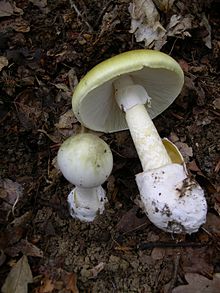| Amanita phalloides | |
|---|---|

| |
| In Piacenza, Italy | |
| Scientific classification | |
| Domain: | Eukaryota |
| Kingdom: | Fungi |
| Division: | Basidiomycota |
| Class: | Agaricomycetes |
| Order: | Agaricales |
| Family: | Amanitaceae |
| Genus: | Amanita |
| Species: | A. phalloides
|
| Binomial name | |
| Amanita phalloides | |
| Amanita phalloides | |
|---|---|
| Gills on hymenium | |
| Cap is convex or flat | |
| Hymenium is free | |
| Stipe has a ring and volva | |
| Spore print is white | |
| Ecology is mycorrhizal | |
| Edibility is deadly | |
Amanita phalloides (/æməˈnaɪtə fəˈlɔɪdiːz/), commonly known as the death cap, is a deadly poisonous basidiomycete fungus and mushroom, one of many in the genus Amanita. Originating in Europe[1] but later introduced to other parts of the world since the late twentieth century,[2][3][4][5] A. phalloides forms ectomycorrhizas with various broadleaved trees. In some cases, the death cap has been introduced to new regions with the cultivation of non-native species of oak, chestnut, and pine. The large fruiting bodies (mushrooms) appear in summer and autumn; the caps are generally greenish in colour with a white stipe and gills. The cap colour is variable, including white forms, and is thus not a reliable identifier.
These toxic mushrooms resemble several edible species (most notably Caesar's mushroom and the straw mushroom) commonly consumed by humans, increasing the risk of accidental poisoning. Amatoxins, the class of toxins found in these mushrooms, are thermostable: they resist changes due to heat, so their toxic effects are not reduced by cooking.
Amanita phalloides is the most poisonous of all known mushrooms.[6][7][8] It is estimated that as little as half a mushroom contains enough toxin to kill an adult human.[9] It is also the deadliest mushroom worldwide, responsible for 90% of mushroom-related fatalities every year.[10] It has been involved in the majority of human deaths from mushroom poisoning,[11] possibly including Roman Emperor Claudius in AD 54 and Holy Roman Emperor Charles VI in 1740.[12] It has also been the subject of much research and many of its biologically active agents have been isolated. The principal toxic constituent is α-Amanitin, which causes liver and kidney failure.
- ^ Cai, Qing; Tulloss, Rodham E; Tang, Li P; Tolgor, Bau; Zhang, Ping; Chen, Zuo H; Yang, Zhu L (21 June 2014). "Multi-locus phylogeny of lethal amanitas: Implications for species diversity and historical biogeography". BMC Evolutionary Biology. 14 (1): 143. Bibcode:2014BMCEE..14..143C. doi:10.1186/1471-2148-14-143. ISSN 1471-2148. PMC 4094918. PMID 24950598.
- ^ Cite error: The named reference
Litten75was invoked but never defined (see the help page). - ^ Cite error: The named reference
MedJAus1993was invoked but never defined (see the help page). - ^ Cite error: The named reference
Kurtziana1983was invoked but never defined (see the help page). - ^ Pringle, Anne; Adams, Rachel I.; Cross, Hugh B.; Bruns, Thomas D. (18 February 2009). "The ectomycorrhizal fungus Amanita phalloides was introduced and is expanding its range on the west coast of North America". Molecular Ecology. 18 (5): 817–833. Bibcode:2009MolEc..18..817P. doi:10.1111/j.1365-294X.2008.04030.x. ISSN 0962-1083. PMID 19207260.
- ^ Rajarathnam, S.; Shashirekha, M.N. (2003), "MUSHROOMS AND TRUFFLES | Use of Wild Mushrooms", Encyclopedia of Food Sciences and Nutrition, Elsevier, pp. 4048–4054, doi:10.1016/b0-12-227055-x/00813-0, ISBN 978-0-12-227055-0, retrieved 3 June 2024
- ^ Madore, François; Bouchard, Josée (2019), "Plasmapheresis in Acute Intoxication and Poisoning", Critical Care Nephrology, Elsevier, pp. 595–600.e3, doi:10.1016/b978-0-323-44942-7.00100-x, ISBN 978-0-323-44942-7, retrieved 25 July 2024
- ^ Wiegand, Timothy J. (2024), "Mushrooms, cyclopeptide", Encyclopedia of Toxicology, Elsevier, pp. 549–553, doi:10.1016/b978-0-12-824315-2.01020-4, ISBN 978-0-323-85434-4, retrieved 3 June 2024
- ^ Madore, François; Bouchard, Josée (2019), "Plasmapheresis in Acute Intoxication and Poisoning", Critical Care Nephrology, Elsevier, pp. 595–600.e3, doi:10.1016/b978-0-323-44942-7.00100-x, ISBN 978-0-323-44942-7, retrieved 3 June 2024
- ^ Moor-Smith, Maxwell; Li, Raymond; Ahmad, Omar (2019). "The world's most poisonous mushroom, Amanita phalloides, is growing in BC". British Columbia Medical Journal. 61 (1) – via BMCJ.
- ^ Benjamin, p.200.
- ^ Cite error: The named reference
wassonwas invoked but never defined (see the help page).